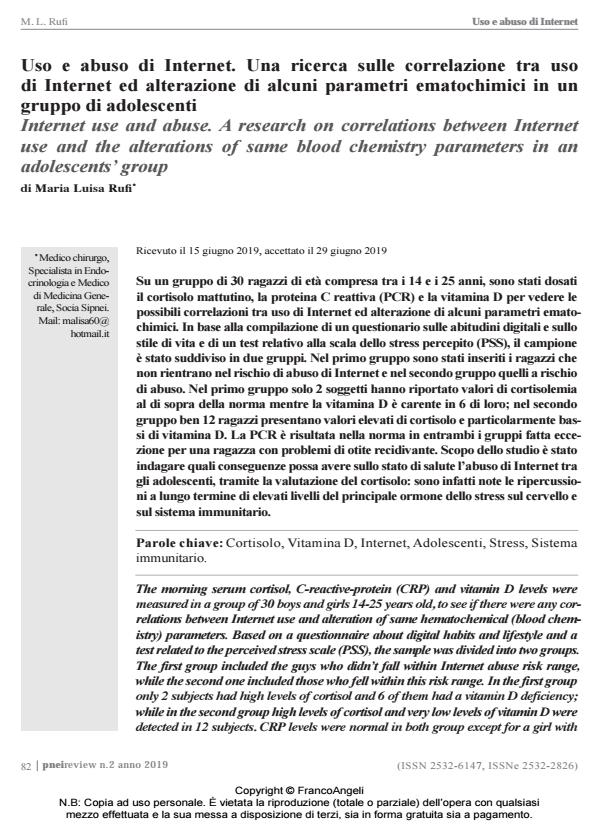Internet use and abuse. A research on correlations between Internet use and the alterations of same blood chemistry parameters in an adolescents’ group
Journal title PNEI REVIEW
Author/s Maria Luisa Rufi
Publishing Year 2019 Issue 2019/2 Language Italian
Pages 9 P. 82-90 File size 112 KB
DOI 10.3280/PNEI2019-002008
DOI is like a bar code for intellectual property: to have more infomation
click here
Below, you can see the article first page
If you want to buy this article in PDF format, you can do it, following the instructions to buy download credits

FrancoAngeli is member of Publishers International Linking Association, Inc (PILA), a not-for-profit association which run the CrossRef service enabling links to and from online scholarly content.
The morning serum cortisol, C-reactive-protein (CRP) and vitamin D levels were measured in a group of 30 boys and girls 14-25 years old, to see if there were any correlations between Internet use and alteration of same hematochemical (blood chemistry) parameters. Based on a questionnaire about digital habits and lifestyle and a test related to the perceived stress scale (PSS), the sample was divided into two groups. The first group included the guys who didn’t fall within Internet abuse risk range, while the second one included those who fell within this risk range. In the first group only 2 subjects had high levels of cortisol and 6 of them had a vitamin D deficiency; while in the second group high levels of cortisol and very low levels of vitamin D were detected in 12 subjects. CRP levels were normal in both group except for a girl with a problem of relapsing otitis. Purpose of the study was to investigate which consequences on the health state Internet abuse could have among adolescents, through the evaluation of cortisol: indeed, the long-term repercussions of high levels of the main stress hormone on the brain and on the immune-system are known.
Keywords: Cortisol, Vitamin D, Internet, Adolescents, Stress, Immune system.
- Bottaccioli F. e Bottaccioli A.G. (2017). Psiconeuroendocrinoimmunologia e scienza della cura integrata. Il manuale. Milano: Edra, pp. 135-142.
- Bowlby J. (1989). Una base sicura. Milano: Raffaello Cortina.
- Bowlby J. (1975). Attaccamento e perdita. La separazione dalla madre. Torino: Bollati Boringhieri.
- Caretti V. e La Barbera D. (2005). Le dipendenze patologiche: clinica e psicopatologia. Milano: Raffaello Cortina, pp. 11, 14, 115.
- Couyoumdjian A., Baiocco R. e Del Miglio C. (2006). Le nuova dipendenze in adolescenza: basi teoriche, fattori di rischio e prevenzione. Roma: Laterza.
- Lingiardi V. e Gazzillo F. (2014). La personalità e i suoi disturbi. Milano: Raffaello Cortina, pp. 824-833.
- Nicoli M., Formella Z. e Szadejko K. (2015). Uso di Internet e autostima. Ricerca esplorativa su un gruppo di adolescenti di Roma e Provincia. Orientamenti pedagogici, 62(2): 293-310.
- Nicoli M. e Formella Z. (2014). Uso e abuso di Internet negli adolescenti. Un’indagine esplorativa nelle scuole secondarie di secondo grado. Psicologia dell’educazione, 8(3): 357-366.
- Rosenberg K. e Feder L.C. (2015). Dipendenze comportamentali. Criteri, evidenze e trattamento. Milano: Edra.
- Tonioni F. (2011). Quando Internet diventa una droga. Torino: Einaudi.
- Tonioni F. (2013). Psicopatologia Web mediata. Dipendenza da Internet e nuovi fenomeni dissociativi. Milano: Springer.
- Young K.S. (1998). Internet addiction: the emergence of a new clinical disorder. Cyberpsychol. Behav. Soc. Netw., 1(3): 233-244.
- Young K.S. (2000). Presi nella rete. Intossicazione e dipendenza da Internet. Bologna: Calderini.
Maria Luisa Rufi, Uso e abuso di Internet. Una ricerca sulle correlazione tra uso di Internet ed alterazione di alcuni parametri ematochimici in un gruppo di adolescenti in "PNEI REVIEW" 2/2019, pp 82-90, DOI: 10.3280/PNEI2019-002008